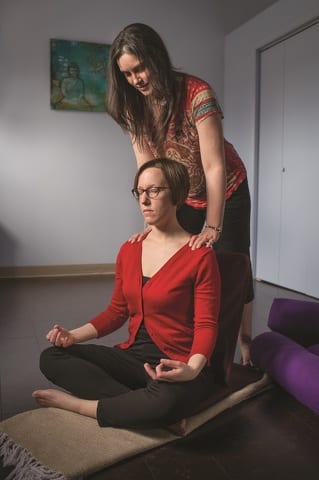This installment of “Help Me!” is a little more, well, existential than the others in the series thus far. As soon as I read Vincent’s stories about ballroom dancing and buying some more stylish clothes, I knew this series would be the perfect excuse for me to try something I’ve been meaning to do for years: meditation.
At a time when an endless barrage of information and requests is rarely more than arm’s length away, we could all stand to disconnect from technology and reconnect with our thoughts. I took the plunge into meditation a few weeks ago, and I’m really glad I did.
A little background: I have a full-time job at Penn State, teaching and writing gigs on the side, and am involved with several community groups. My mind is a big to-do list that can be difficult to turn off, which can make it difficult to focus.
I practice yoga regularly and knew that meditation would be a nice complement to it, but I resisted trying it because I thought it would be uncomfortable. Luckily, I have plenty of other things going on, so there was always a reason to put it off. After this series started, though, I saw an opportunity I couldn’t pass up.
There are a lot of meditation options in the Centre Region. Several yoga studios offer weekly classes, Penn State Health and Wellness holds workshops, and solo practitioners like Sakarra Rae Stefaniak work to address individual client needs.
Stefaniak, who owns and operates Shealer Alchemy for Women, was my meditation guide. She started meditating about 10 years ago to quiet her own mind and manage an autoimmune condition.
“It really brought profound changes where I could look at my body and separate sensations from suffering,” she says. “That shifted something for me, both with anxiety and in my body.”
Over the course of a month, I attended one of Stefaniak’s workshops at Wellness in Motion, one of her weekly classes at Serenity Wellness Centre, and participated in a one-on-one session. Each experience was different, but they all followed the same general theme – staying grounded when things get crazy.
In a nutshell, meditation involves sitting, standing, or otherwise being in a comfortable position and doing nothing but focusing on breathing or reciting a mantra. Like a lot of things, it’s difficult at first but becomes easier over time.
During the sessions, I found myself thinking about places where I felt most comfortable and at ease, like sitting in a camp chair at a music festival in Virginia I attend every summer. In fact, I was so calm and relaxed that I’m pretty sure I fell asleep during one of the group sessions – which Stefaniak says is not uncommon.
Everyone in the two group sessions I attended seemed to be there for similar reasons. Some had been practicing meditation for years, while others were newbies like me. Either way, Stefaniak made them feel welcome and it was clear from minute one that the studio space was a judgment-free zone.
“The room is a little more energized in a group setting,” Stefaniak says. “It feels supportive and a little more connected because everyone is there for the same purpose. There’s a greater ripple effect than you have practicing one-on-one.”
I didn’t find it too difficult to be away from my phone, but I would find myself fixated on whatever email I’d just read or social media notification I saw just before class began. It took a conscious effort, combined with Stefaniak’s instruction, to reset my mind and focus on the present moment instead of what was waiting for me on the screen.
As our dependence on technology grows, Stefaniak says people are looking to meditation, yoga, and other activities as a way to re-establish human connections in our digital lives.
“We have more anxiety and more loneliness, even though we’re more connected than we’ve ever been before,” she says.
My final meeting with Stefaniak took place on a warm early April day, so we decided to do a walking meditation. Putting my bare feet in the grass and going for a slow, mindful stroll was enough to bring a sense of calm to what had otherwise been a hectic day at work.
By the end of our time together, meditation began to feel less foreign and like something I could regularly do. Stefaniak says this is a common theme from her clients.
“It takes a few weeks to form any habit and stop feeling like work,” she says. “But then once you get in the habit, it doesn’t feel like work.”
Now that I have a few sessions under my belt, I regret not trying it sooner. Am I going to become a Zen master? Probably not, but I did download a meditation app and plan to continue practicing on my own and continue attending Stefaniak’s group classes and workshops.
The ultimate goal, she says, is to be able to meditate anywhere, not just in a pre-defined class or time that you set aside with a meditation app.
I’m not sure I’ll ever get there, but if you see me around town sitting somewhere with my eyes closed and breathing deeply, chances are my mind will be off in a field in the middle of Virginia with my feet in the grass, listening to music.
Jenna Spinelle is a freelance writer in State College.



